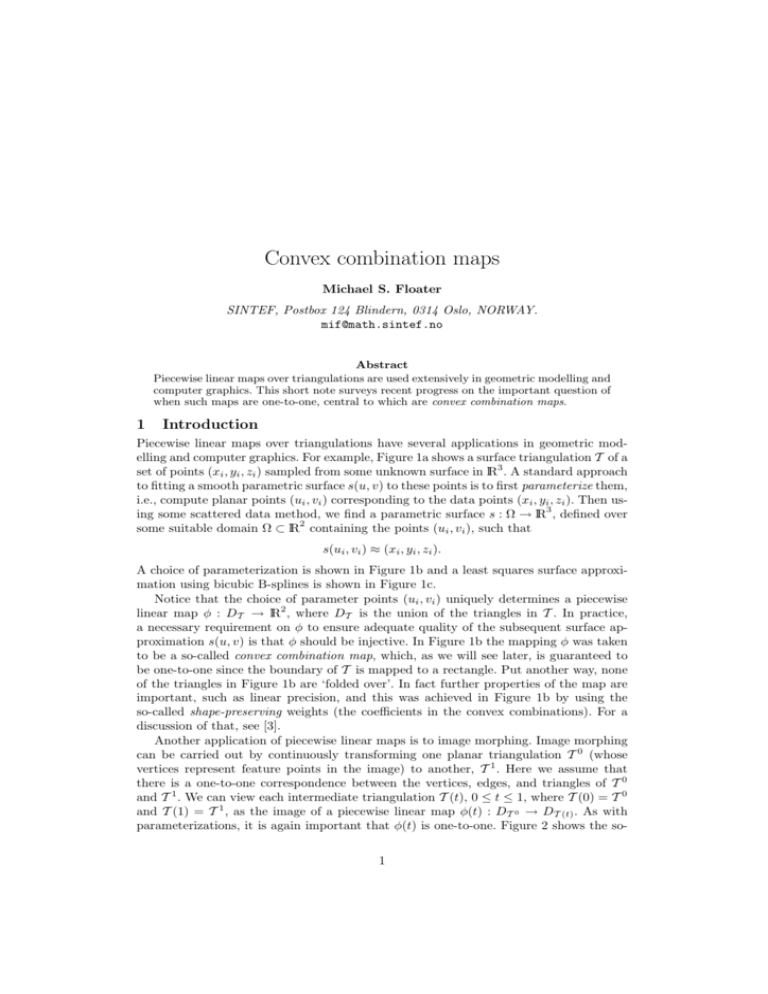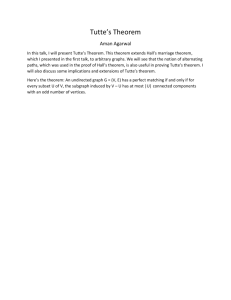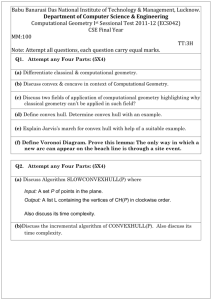Convex combination maps
advertisement

Convex combination maps
Michael S. Floater
SINTEF, Postbox 124 Blindern, 0314 Oslo, NORWAY.
mif@math.sintef.no
Abstract
Piecewise linear maps over triangulations are used extensively in geometric modelling and
computer graphics. This short note surveys recent progress on the important question of
when such maps are one-to-one, central to which are convex combination maps.
1
Introduction
Piecewise linear maps over triangulations have several applications in geometric modelling and computer graphics. For example, Figure 1a shows a surface triangulation T of a
set of points (xi , yi , zi ) sampled from some unknown surface in lR3 . A standard approach
to fitting a smooth parametric surface s(u, v) to these points is to first parameterize them,
i.e., compute planar points (ui , vi ) corresponding to the data points (xi , yi , zi ). Then using some scattered data method, we find a parametric surface s : Ω → lR3 , defined over
some suitable domain Ω ⊂ lR2 containing the points (ui , vi ), such that
s(ui , vi ) ≈ (xi , yi , zi ).
A choice of parameterization is shown in Figure 1b and a least squares surface approximation using bicubic B-splines is shown in Figure 1c.
Notice that the choice of parameter points (ui , vi ) uniquely determines a piecewise
linear map φ : DT → lR2 , where DT is the union of the triangles in T . In practice,
a necessary requirement on φ to ensure adequate quality of the subsequent surface approximation s(u, v) is that φ should be injective. In Figure 1b the mapping φ was taken
to be a so-called convex combination map, which, as we will see later, is guaranteed to
be one-to-one since the boundary of T is mapped to a rectangle. Put another way, none
of the triangles in Figure 1b are ‘folded over’. In fact further properties of the map are
important, such as linear precision, and this was achieved in Figure 1b by using the
so-called shape-preserving weights (the coefficients in the convex combinations). For a
discussion of that, see [3].
Another application of piecewise linear maps is to image morphing. Image morphing
can be carried out by continuously transforming one planar triangulation T 0 (whose
vertices represent feature points in the image) to another, T 1 . Here we assume that
there is a one-to-one correspondence between the vertices, edges, and triangles of T 0
and T 1 . We can view each intermediate triangulation T (t), 0 ≤ t ≤ 1, where T (0) = T 0
and T (1) = T 1 , as the image of a piecewise linear map φ(t) : DT 0 → DT (t) . As with
parameterizations, it is again important that φ(t) is one-to-one. Figure 2 shows the so1
2
Michael S. Floater
called convex combination morph of [4] of two given planar triangulations: T 0 appears
on the left and T 1 on the right. The two triangulations in the middle are T (1/3) and
T (2/3). This morph ensures that φ(t) is one-to-one for all t in [0, 1] and therefore T (t)
has no ‘folded’ triangles at any time instant t.
Piecewise linear maps also arise in: texture mapping; numerical grid generation; and
in setting up multiresolution frameworks, i.e., nested spaces of piecewise linear functions,
for manifold surface triangulations in computer graphics.
Fig. 1. Spatial triangulation (1a), Convex combination parameterization (1b), Bicubic spline approximation (1c)
Fig. 2. Convex combination morph
2
Convex combination maps
For the sake of simplicity we will only discuss convex combination maps defined over
planar triangulations even though all the results hold equally well when the domain of
the map is a spatial triangulation such as that in Figure 1a. Thus let T = {T1 , . . . , TM }
be
Ti ⊂ lR2 , and let DT =
S a simply-connected planar triangulation, with closed triangles
2
T ∈T T , as in Figure 3. We will call a mapping φ : DT → lR a convex combination
map if it is piecewise linear over T and, for every interior vertex v of T , there exist
weights λvw > 0, for w ∈ Nv , such that
X
λvw = 1,
w∈Nv
3
Convex combination maps
and
φ(v) =
X
λvw φ(w),
(1)
w∈Nv
where Nv is the set of neighbours of v; see Figure 3.
DT
φ
Ω
Fig. 3. Convex combination map
In applications, the mapped boundary vertices φ(v) are chosen first. Then the weights
λvw are all specified according to some chosen strategy. Then finally the mapped interior
vertices are found by treating the equations in (1) as a linear system.
Example 1. If an interior vertex v of T has five neighbours v1 , . . . , v5 , then we might
set
1
1
1
1
1
φ(v) = φ(v1 ) + φ(v2 ) + φ(v3 ) + φ(v4 ) + φ(v5 ).
4
8
8
4
4
Until recently, the only theory behind convex combination maps was that of Tutte [8].
Working from a purely graph-theoretic point of view, Tutte proposed a so-called barycentric mapping for constructing straight line drawings of 3-connected graphs (which include
triangulations). A barycentric mapping in our context is simply a convex combination
map in which all the weights at each vertex are equal, i.e., λvw = 1/dv , where dv is the
degree or valency of the vertex v. Thus for v in Example 1 we must have
1
1
1
1
1
φ(v) = φ(v1 ) + φ(v2 ) + φ(v3 ) + φ(v4 ) + φ(v5 ).
5
5
5
5
5
Tutte showed that a valid straight line drawing, i.e. one with no edge crossings, results
from a barycentric mapping if the ‘boundary’ of the graph, a so-called ‘cycle’, is mapped
to a convex polygon. However, as argued in [3], convex combination maps share all those
properties of barycentric maps necessary for Tutte’s proof. Thus when interpreted in the
right way and suitably generalized, Tutte’s theorem can be expressed in the following
way.
Theorem 1. Suppose φ : DT → lR2 is a convex combination mapping which maps the
n boundary vertices of T cyclically into the n vertices of some n-sided convex polygon
in the plane. Then φ is one-to-one.
Despite this generalization, however, there are still two aspects of it which need to
be improved from the point of view of applications and future research.
The first is that we would like to extend the theorem so that we can allow some, and
indeed many, of the mapped boundary vertices to be collinear. Indeed in the application
4
Michael S. Floater
to parameterization for surface fitting, it might be convenient to map all the boundary
vertices of the given triangulation into the four sides of a rectangle, as in Figure 1b.
This is because tensor-product splines surfaces are defined over rectangular domains.
Collinearity will also often be desirable in morphing, as in Figure 2, and in most other
applications. Thus a drawback of Theorem 1 is that it does not allow collinear vertices
in the image boundary.
The second aspect is that we would like to simplify the proof in order to have some
hope of establishing the injectivity of piecewise linear maps in even more general situations, such as when mapping to non-convex regions, or when some of the mapped vertices
are constrained, for example. The fact that Tutte’s proof relies on the non-existence of
the Kuratowski subgraphs K5 and K3,3 in a planar graph illustrates its complexity.
It is these two improvements that are the focus of [5]. The main idea of [5] is the
observation that Theorem 1 is very similar to a theorem on harmonic maps, referred to by
Duren and Hengartner [2] as the Radó-Kneser-Choquet thereom, which was established
in [7, 6, 1]. Recall that a mapping φ : D → lR2 , with D ⊂ lR2 and φ = (u, v), is harmonic
if both its components u(x, y) and v(x, y) satisfy the Laplace equation in D, i.e.,
uxx + uyy = 0,
vxx + vyy = 0;
see Figure 4.
Radó-Kneser-Choquet Theorem. Suppose φ : D → lR2 is a harmonic mapping
which maps the boundary ∂D homeomorphically into the boundary ∂Ω of some convex
region Ω ⊂ lR2 . Then φ is one-to-one.
φ
D
Ω
Fig. 4. Harmonic map
This suggested that a proof of Theorem 1 might be based on a proof of the RadóKneser-Choquet theorem, in particular the short proof of Kneser [6]. Kneser’s proof
begins by showing that φ is locally one-to-one in the sense that the Jacobian of φ,
¯
¯
¯ ux uy ¯
¯
¯
¯ vx vy ¯
never vanishes. Kneser establishes this by supposing that the Jacobian is zero at some
point (x0 , y0 ) ∈ D. In that case there must be a straight line ax + by + c = 0 passing
through the point φ(x0 , y0 ) such that both partial derivatives of the function h(x, y) =
au(x, y) + bv(x, y) + c are zero at (x0 , y0 ). At the same time, the function h : D → lR
is zero at (x0 , y0 ) and has just two zeros along the boundary of D. Noting that h(x, y)
Convex combination maps
is a harmonic function, Kneser then uses the Nodal Lines theorem of Courant to argue
that there are at least four zero contours of h emanating from (x0 , y0 ) and due to
the maximum principle for h, these four curves can never self-intersect nor intersect one
another. Therefore all four curves must reach the boundary of D which is a contradiction.
These ideas were adapted in [5] to establish a much simpler proof of Theorem 1 than
that of Tutte. No graph theory is needed. Instead, the discrete maximum principle for
convex combination functions plays the role of the maximum principle for harmonic
functions. Similar to Kneser’s proof we show first that φ is locally one-to-one, except
that we understand this to mean that the restriction of φ to any quadrilateral in T is
one-to-one, a quadrilateral being the union of two triangles sharing a common edge.
v1
v2
Fig. 5. Dividing edges
Moreover, Theorem 1 is generalized in [5] to allow collinear mapped boundary vertices.
We call an edge [v, w] of T a dividing edge if both endpoints v and w are boundary
vertices yet the edge [v, w] itself is not contained in the boundary. For example in Figure
5, the only dividing edge in the triangulation is [v1 , v2 ]. Dividing edges play a critical
role because they partition the triangulation into subtriangulations Ti , in each of which
every convex combination function satisfies a discrete maximum principle in its strong
form. The main result of [5] was the following.
Theorem 2. Suppose T is any triangulation and that φ : DT → lR2 is a convex
combination mapping which maps ∂D homeomorphically into the boundary ∂Ω of some
convex region Ω ⊂ lR2 . Then φ is one-to-one if and only if no dividing edge [v, w] of T
is mapped by φ into ∂Ω.
3
Future research
Here is a list of topics for future research.
• A triangulation is a special (maximal) kind of planar graph. Can one extend Theorem 2 to other planar graphs, for example, rectangular grids? This is likely because
Tutte’s theory already holds for all 3-connected graphs.
• In what way can the theorem be extended from bivariate maps to trivariate ones?
5
6
Michael S. Floater
• Can similar one-to-one maps be guaranteed when mapping closed surfaces of given
topology to one another? For example, we would like to map a closed manifold
triangulation, homeomorphic to a sphere, into a unit sphere injectively. Here each
triangle in the triangulation would be mapped to a spherical triangle on the surface
of the sphere.
• Can one find sufficient conditions for the injectivity of constrained maps, i.e., piecewise linear maps in which the image of certain interior points is specified in advance?
• Can one remove the requirement of having to map the boundary to a convex polygon
and still ensure a one-to-one mapping under some weaker condition?
• Can the Radó-Kneser-Choquet thereom and Theorem 2 be combined as part of a
single more general theorem?
Bibliography
1. G. Choquet, Sur un type de transformation analytique généralisant la représentation
conforme et définé au moyen de fonctions harmoniques, Bull. Sci. Math. 69 (1945),
156–165.
2. P. Duren and W. Hengartner, Harmonic mappings of multiply connected domains,
Pac. J. Math. 180 (1997), 201–220.
3. M. S. Floater, Parametrization and smooth approximation of surface triangulations,
Comp. Aided Geom. Design 14 (1997), 231–250.
4. M. S. Floater and C. Gotsman, How to morph tilings injectively, J. Comp. Appl.
Math. 101 (1999), 117–129.
5. M. S. Floater, One-to-one piecewise linear mappings over triangulations, preprint,
University of Oslo, June 2001.
6. H. Kneser, Lösung der Aufgabe 41, Jahresber. Deutsch. Math.-Verien. 35, (1926),
123–124.
7. T. Radó, Aufgabe 41, Jahresber. Deutsch. Math.-Verien. 35, (1926), 49.
8. W. T. Tutte, How to draw a graph, Proc. London Math. Soc. 13 (1963), 743–768.






